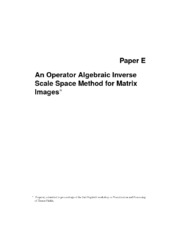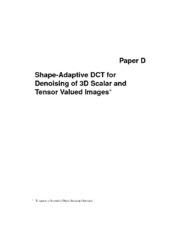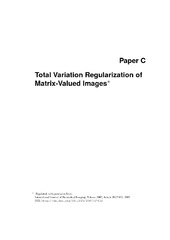| dc.rights.license | The work can be used, that is be referred to, linked to, cited from, printed and downloaded, within the frames of Act No. 2 of 12 May 1961 Relating to copyright in literary, scientific and artistic works, etc., with subsequent Amendments. | en_US |
| dc.contributor.author | Christiansen, Oddvar | eng |
| dc.date.accessioned | 2008-10-21T13:41:34Z | |
| dc.date.available | 2008-10-21T13:41:34Z | |
| dc.date.copyright | 2008 | eng |
| dc.date.issued | 2008-02-01 | eng |
| dc.identifier.isbn | 978-82-308-0502-2 (print version) | en_US |
| dc.identifier.uri | https://hdl.handle.net/1956/2821 | |
| dc.description.abstract | In medicine digital images play a vital role in both research and clinical work. Using advanced techniques like Magnetic Resonance Imaging (MRI), Computertomografi (CT), Positron Emission Tomography (PET) or X-ray, images of the inside of the body can be made in vivo. In order to extract as much information as possible from the data, advanced image processing techniques are used. 3D techniques can be used to make advanced visualization, segmentation can be used to separate the different tissue parts, feature extraction can be used for automatic diagnostics and noise removal methods can be used to improve the image quality. This is just a few of the possibilities image processing offers. However, many of the techniques are closely related. In order to make a proper visualization, the different body parts need to be segmented and in order to make a good segmentation, noise needs to be removed. A relatively new MRI modality is Diffusion Tensor Imaging (DTI) [5]. Using this new modality, it is possible to construct a model of the nerve fibers in the human brain. Tracing these fibers the wiring of the brain can be studied. This is however not a trivial task. By construction the DTI images are corrupted by a large amount of noise, making it hard to decide the location of the fibers. Using different noise removal methods it is possible to remove or reduce the noise in the DTI data, and the main part of this thesis is devoted to such methods [7, 32, 33, 54]. In addition to the noise removal algorithms we propose an efficient method for image segmentation [34, 88]. This method is based on intensity based segmentation, meaning that the intensity in the image is used to divide it into different regions. In general these methods are closely related to noise removal algorithms and can be seen as a combined noise removal and projection algorithm. All except for one of the proposed methods are so-called variational methods. In general the variational methods are derived from a cost functional, which needs to be minimized. A common way to solve the minimization problem is to find the corresponding Euler-Lagrange equation and use the method of steepest descent. This leads to a partial differential equation (PDE), which is solved to steady state. In addition to the variational methods, we propose a transformed based denoising method [7]. This method uses a shape-adaptive discrete cosine transform (SA-DCT) to transform the image into the frequency domain. In the frequency domain small coefficients are thresholded, which suppress the majority of the noise. The proposed transform based method is compared to the PDE based method. An image can be viewed as a function sampled on a mesh. Usually this mesh is rectangular (2D) or cubic (3D), and in two dimensions the elements are called pixels and in three dimensions the elements are called voxels. In practice the image domain is discrete. However, when developing mathematical models it is customary to view the domain as continuous. Thus mathemtically we assume that the image is a continous mapping from the image domain Ω to the real numbers R, i.e. f : Ω→R. (1) The function f can be scalar-, vector- or tensor-valued. We will assume that the image is corrupted by additive noise, i.e. u = f + σ. (2) Here f is the true image, σ is the noise level and u is the observed image. The noise is Gaussian with zero mean and variance σ2. The introduction is outlined as follows: In Chapter 1 we give an overview of MRI and DTI. In Chapter 2 we give an introduction to PDE based image segmentation. In Chapter 3 we give an introduction to PDE and transformed based denoising methods. In Chapter 4 we give a short summery of the six papers and in the last chapter we give a conclusion of the achieved results. | en_US |
| dc.language.iso | eng | eng |
| dc.publisher | The University of Bergen | en_US |
| dc.relation.haspart | Paper A: International Journal of Computer Vision 73(1), Image Segmentation Using Some Piecewise Constant Level Set Methods with MBO Type of Projection, pp. 61-76. Copyright 2007 Springer. All rights reserved. Abstract only. Full-text not available due to publisher restrictions. The published version is available at: <a href="http://dx.doi.org/10.1007/s11263-006-9140-x" target=_"blank">http://dx.doi.org/10.1007/s11263-006-9140-x</a> | en_US |
| dc.relation.haspart | Paper B: Mathematics and Visualization, Image Processing Based on Partial Differential Equations, Part IV, Christiansen, Oddvar and Xue-Cheng Tai, Fast implementation of piecewise constant level set methods, pp. 289-308, 2007. Copyright 2007 Springer. All rights reserved. Full-text not available due to publisher restrictions. The published version is available at: <a href="http://dx.doi.org/10.1007/978-3-540-33267-1_16" target=_"blank">http://dx.doi.org/10.1007/978-3-540-33267-1_16</a> | en_US |
| dc.relation.haspart | Paper C: International Journal of Biomedical Imaging (2007), Article ID 27432, Christiansen, Oddvar; Lee, Tin-Man; Lie, Johan; Sinha, Usha and Tony F. Chan, Total Variation Regularization of Matrix-Valued Images, 11 pages. Copyright © 2007 Oddvar Christiansen et al. Published by Hindawi Publishing Corporation. <a href="http://dx.doi.org/10.1155/2007/27432" target=_"blank">http://dx.doi.org/10.1155/2007/27432 </a> This is an open access article distributed under the Creative Commons Attribution License, which permits unrestricted use, distribution, and reproduction in any medium, provided the original work is properly cited. | en_US |
| dc.relation.haspart | Paper D: Journal of Digital Imaging, Bergmann, Ørjan; Christiansen, Oddvar; Lie, Johan and Arvid Lundervold, Shape-Adaptive DCT for Denoising of 3D Scalar and Tensor Valued Images. Authors accepted postprint. Copyright 2007 Society for Imaging Informatics in Medicine. Published by Springer New York. All rights reserved. The published version is available at: <a href="http://dx.doi.org/10.1007/s10278-007-9088-6" target=_"blank">http://dx.doi.org/10.1007/s10278-007-9088-6</a> | en_US |
| dc.relation.haspart | Paper E: Lie, Johan; Burgeth, Bernhard and Oddvar Christians, An Operator Algebraic Inverse Scale Space Method for Matrix Images. Preprint, submitted to proceedings of the 2nd Dagstuhl workshop on Visualization and Processing of Tensor Fields. Copyright 2007 Lie et al. | en_US |
| dc.relation.haspart | Paper F: Christiansen, Oddvar; Lie, Johan; Burghet, Bernhard, A dual operator algebraic method for regularization of matrix valued images. Authors accepted version. Abstract only. Full-text not available due to publisher restrictions. To be published in Inverse Problems and Imaging. Copyright 2007 AIMSciences. | en_US |
| dc.title | Mathematical Segmentation and Denoising of Images with Applications to MRI and Diffusion Tensor MRI | en_US |
| dc.type | Doctoral thesis | |
| dc.rights.holder | Oddvar Christiansen | en_US |
| dc.subject.nsi | VDP::Matematikk og Naturvitenskap: 400::Matematikk: 410 | nob |



